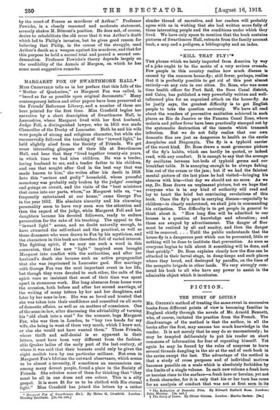MARGARET FOX OF SWARTHMORE HALL.* Miss CROSFIELD tells us in
her preface that this Life of the "Mother of Quakerism," as Margaret Fox was called, is "based as far as possible upon original documents." Many contemporary letters and other papers have been preserved at the Friends' Reference Library, and a number of these are here printed for the first time. Miss Crosfield begins her narrative by a short description of Swarthmore Hall, in Lancashire, where Margaret lived with her first husband, Judge Fell, a distinguished lawyer, who in 1655 was made Chancellor of the Duchy of Lancaster. Both he and his wife were people of strong and religious character, but while she unreservedly followed the teaching of the " inward light," he held slightly aloof from the Society of Friends. We get some interesting glimpses of their life at Swarthmore Hall, and hear that they "lived together twenty-six years, in which time we had nine children. He was a tender, loving husband to me, and a tender father to his children, and one that sought after God in the best way that was made known to him," she writes after his death in 1658. Into this "serious and godly" household, whose peaceful monotony was probably only broken by the judges' comings and goings on circuit, and the visits of the " best ministers that came into our parts, whom," as Margaret tells us, " we frequently entertained at our house," came George Fox in the year 1652. His absolute sincerity and his charming personality seem to have very soon won the attention and then the regard of the judge, while Margaret Fell and her daughters became his devoted followers, ready to endure persecution for the sake of his teaching. The appeal to the " inward light " seems, and no doubt naturally enough, to have attracted the self-reliant and the practical, as well as those dreamers who were drawn to Fox by his mysticism, and the characters in this book are therefore full of varied interest. The fighting spirit, if we may use such a word in this connexion, that the new " light " inspired soon brought Margaret into conflict with the authorities, and after her husband's death she became such an active propagandist that she was imprisoned in Lancaster gaol. Her marriage with George Fox was the next important event in her life, but though they were devoted to each other, the calls of the spirit were so insistent that most of their time was spent apart in strenuous work. Her long absences from home were the occasion, both before and after her second marriage, of the writing of many letters by her and her daughters, and later by her sons-in-law. She was so loved and trusted that she was taken into their confidence and consulted on all sorts of domestic affairs, as well as on matters of conscience. One of the sons-in-law, after discussing the advisability of turning his " old cloak into a coat " for the summer, begs Margaret Fox, who was then in London, to "buy two hoods for my wife, she being in want of them very much, which I knew not, or else she would not have wanted them." These Friends, whose thrift and self-denial is so apparent in their letters, must have been very different from the fashion- able Quaker ladies of the early part of the last century, of whom it was said that their bonnets could only be given the right modish turn by one particular milliner. But even in Margaret Fox's lifetime the outward observance, which seems to be almost a necessity, if sometimes an unconscious one, among many devout people, found a place in the Society of Friends. She rebukes some of them for thinking that " they must be all in one dress and one colour. This is a silly gospel. It is more fit for us to be clothed with His eternal light." Miss Crosfield has joined the letters by a rather
• Margaret Fox of Swarthmore Hal. By Helen G. Croefield. London : Headley Brothers. [3s. 6d. net.]
slender thread of narrative, and her readers will probably agree with us in wishing that she bad written more fully of these interesting people and the conditions under which they lived. We have only space to mention that the book contains pictures of Swarthmore Hall, extracts from the family account book, a map and a pedigree, a bibliography and an index.


































 Previous page
Previous page